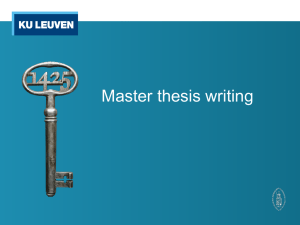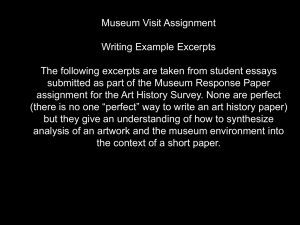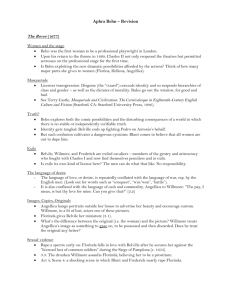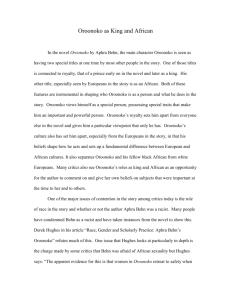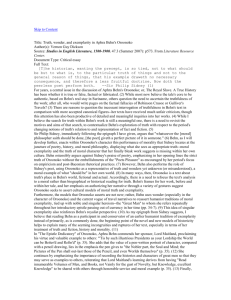Thesis Statement Powerpoint - E28C: Suspicious Characters
advertisement
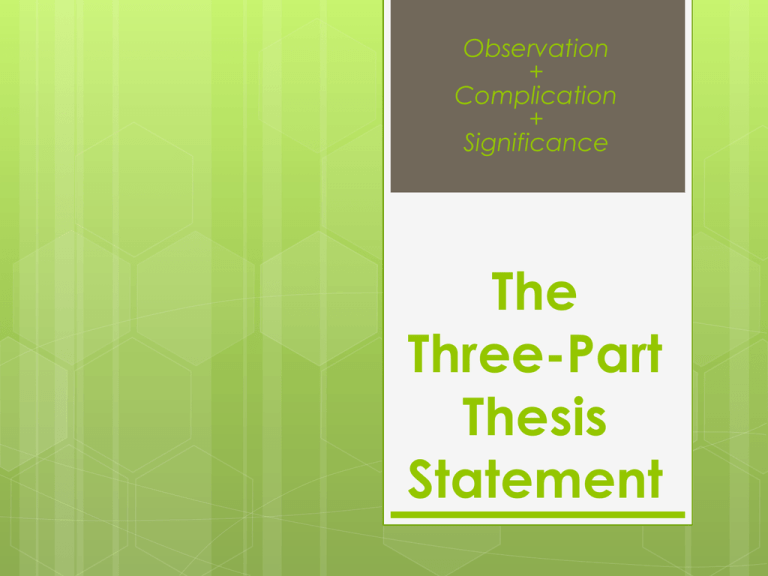
Observation + Complication + Significance The Three-Part Thesis Statement Purpose of the Thesis The thesis, usually expressed in one or two sentences, is the central, organizing claim of your paper. Because each paragraph’s job is to drive an argument forward by proving the thesis, the thesis largely determines the type of paper you get to write. If your claim is complex, you have the option of picking the best arguments for your strong paper and having a lot to talk about. Purpose Continued Your thesis will almost certainly change as you look more closely at your quotes while writing... This is a good thing, usually leading to a more complex, arguable, and significant central idea. Before you turn your paper in, ALWAYS check to make sure that your thesis matches the argument that you’ve ended up writing! If your essay went in an unexpected direction, revise your thesis to fit the essay that you wrote. BASIC THESIS GENERATOR 1. Observation: what you’ve noticed in the text Specific strategy, literary device(s), and/or pattern 2. Complication: how O works/is used/changes What that device, strategy, or pattern does in the text 3. Significance: How O + C together contribute to the author/text’s larger message, reveal larger tensions or concerns, etc So What? Why is this important? O + C reveals/suggests/disproves/etc… Evolving Thesis Statements: O + C •In Melville’s The Tartarus of Maids, images of dead flatness, whiteness, and blankness Observation: pattern/device •emphasize the similarities between female factory workers and the homogenous paper products Complication: creates analogy Significance: MISSING Evolving Thesis Statements: C + S Observation: MISSING •Similarities between female factory workers and the homogenous paper products Complication: creates analogy •suggest that industrialization dangerously replaces vital human reproduction with lifeless industrial production. Significance: reveals historical condition and its hidden effects Evolving Thesis Statements: O + S •In Melville’s The Tartarus of Maids, images of dead flatness, whiteness, and blankness Observation: pattern/device Complication: MISSING •suggest that industrialization dangerously replaces vital human reproduction with lifeless industrial production. Significance: reveals historical condition and its hidden effects Three-Part (O + C + S) Thesis •In Melville’s The Tartarus of Maids, images of dead flatness, whiteness, and blankness Observation: pattern/device •emphasize the similarities between female factory workers and the homogenous paper products Complication: creates analogy •thereby suggesting that industrialization dangerously replaces vital human reproduction with lifeless industrial production. Significance: reveals historical condition and its hidden effects INITIAL THESIS— WHAT’S MISSING? Behn critiques slavery by having the narrator inadvertently turn the subject of Oroonoko into the subject of consumerism just as slavery turns men into commodities. INITIAL THESIS— WHAT’S MISSING? Behn critiques slavery by having the narrator inadvertently turn the subject of Oroonoko into the subject of consumerism just as slavery turns men into commodities. •#1—More specifics on the literary device/strategy •#2—Complication: HOW device/strategy actually works •#3—more specifics about WHY this vague “critique” is important, or what exactly this shift is critiquing. •#4 – Oroonoko wasn’t italicized as the title not character! REVISED THESIS Early in Oroonoko, ambiguity of subject, tone, and pronoun dramatize how language transforms living creatures into property, revealing the hidden complicity of consumerism in the visible economic alchemy of chattel slavery. √ More specifics on the literary devices/strategies √ How Behn actually uses those devices/strategies √ More specific WHY Behn uses that device, the “so what” question Language Problems Behn uses ambiguous language the changing of things, showing the language slavery’s evils. to show people into power of in Language Problems: Revised Early in Oroonoko, ambiguity in subject, tone, and syntax dramatize Behn uses ambiguous language to show how language transforms living creatures into the changing of people into property, revealing the hidden complicity of things, showing the power of consumerism in language in the visible economic alchemy of chattel slavery. slavery’s evils. To Sum It Up: Thesis statements evolve. A thesis with only one or two of the full three is not “bad.” It hasn’t been built up to its optimal level of insight, but that one part is still useful for later evolutions. Keep revising your thesis to match the essay you’re writing and checking to make sure that your essay matches your thesis.


